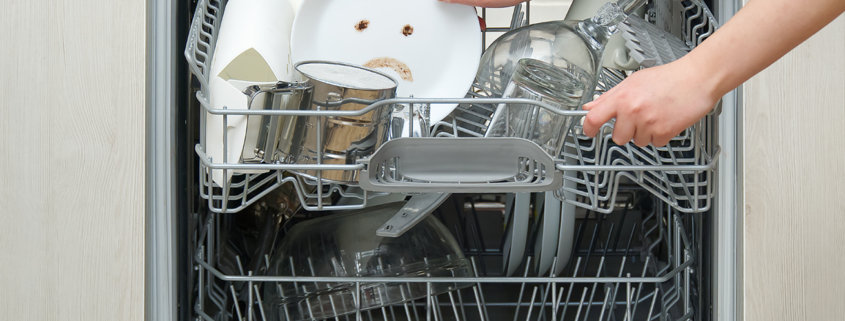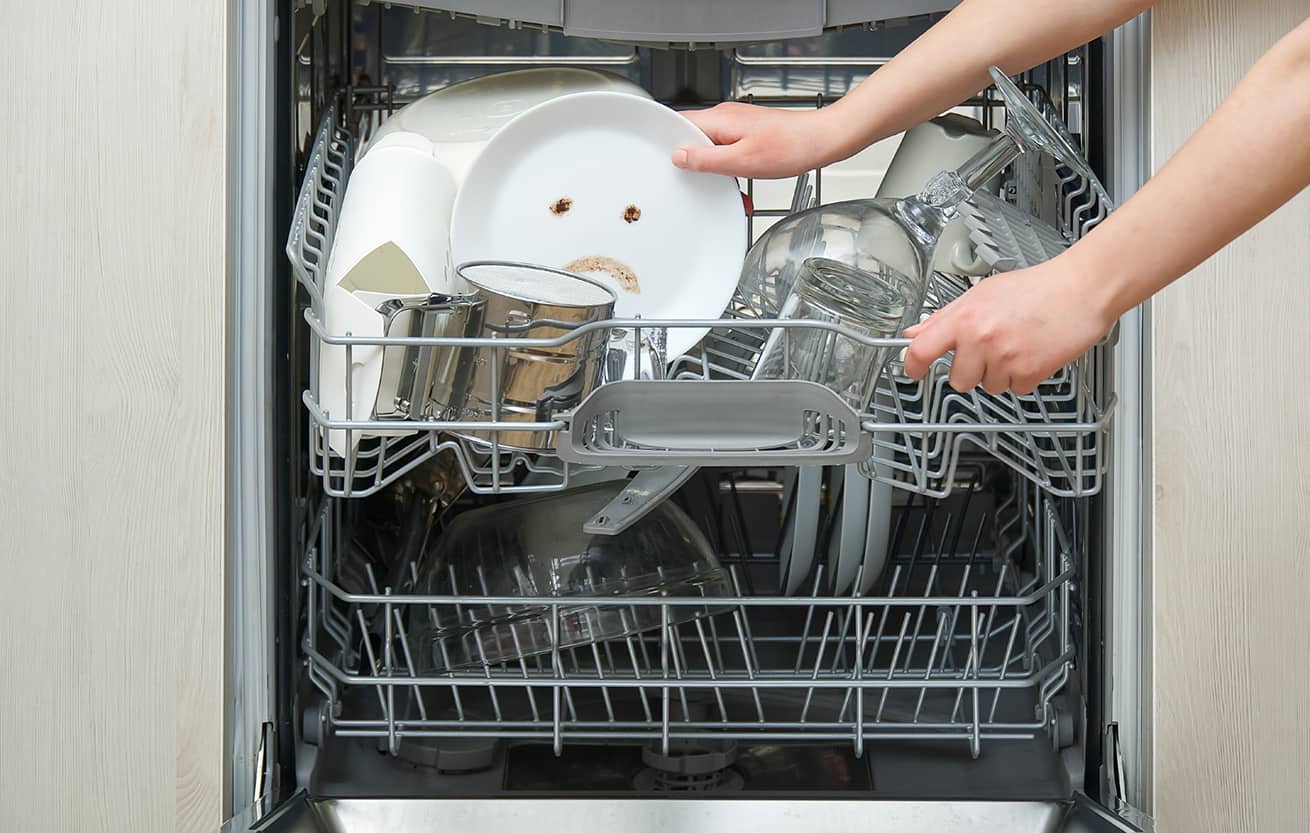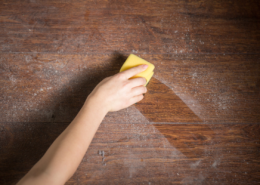7 Easy-to-Fix Reasons Your Dishwasher is Not Cleaning Like It Should
Few things are more disappointing than opening the dishwasher to put away its clean contents, only to be greeted by dirty dishes and cloudy glassware. It’s understandable how you might conclude it’s time to get a new machine. But hold on. Before you toss a perfectly good dishwasher, consider these seven things you may be doing wrong, any one of which may be causing this frustrating situation.
1. Your filter is clogged
So, your dishwasher is not cleaning dishes the way it did when it was new. This may come as a surprise—your dishwasher has a filter that requires regular cleaning. Surprisingly, a clogged filter could be the culprit behind your less-than-clean dishes. If this gunk and goo buildup in your dishwasher, caused by food deposits and hard water, is minor, you can often remedy the situation by running a vinegar cycle.
Pour three cups of white vinegar in the bottom of the empty dishwasher and select the longest cycle. The vinegar will dissolve light mineral buildup and clean gunk from the holes in the spray arm. It will also remove residual grease from the interior walls so dishes will be cleaner and smell better. If that doesn’t fix the problem, and you’re unsure about the location of your dishwasher’s filter, search for your unit’s manual online, and you’ll find the instructions you need. Most filters can be easily rinsed in the sink, although you might need to use a soft-bristled brush for a thorough cleaning.
2. You need to clean the machine
If your dishwasher no longer delivers sparkling clean dishes, it might be an indication that the whole thing needs a thorough cleaning. It’s easy to overlook the fact that appliances designed to clean things also get dirty themselves. And to ensure their optimal performance, it’s essential to keep them clean. Add routing cleaning of your dishwasher into your regular kitchen deep-cleaning routine. You’ll maintain the efficiency and functionality of your dishwasher so that it keeps serving you with impeccably clean dishes.
3. You’re pre-rinsing
If you wonder why dishes come out of your dishwasher with bits of food still stuck to them, it could be because you’re rinsing them first. It seems counterintuitive, but pre-rinsing can make your dishes come out dirtier, not cleaner. That goes for glasses, pots, and silverware, too.
Most dishwashers sold in the past five years or so have a sensor that determines how thorough a wash is needed. At the start of the cycle, it rinses the dishes and then checks how dirty the water is to determine how much time and water it needs to get everything clean. If you’ve already rinsed away much of the muck, the sensor misreads the dishes as already fairly clean. So the dishwasher gives that load a light wash and less than sparkling clean.
To fix that maddening result, don’t rinse; just scrape off bits of loose food with a rubber spatula.
4. Your water temperature is set too low
Water that’s not hot enough won’t effectively clean your dishes. To test your water temperature, run hot water in the sink before starting the dishwasher. Fill a glass and use your candy or meat thermometer to test the water temperature. It should be between 120°F and 150°F. If it’s not, adjust the temperature on your water heater.
Most dishwasher manufacturers stipulate 140°F as the ideal temperature for an automatic dishwasher. However, if you have young children or elderly adults in the household, this may present a scalding issue, so use your best judgment. 120°F is the lowest safe temperature for both your clothes washer and dishwashing.
5. You are not loading correctly
A dishwasher not cleaning properly may be due to this common issue—blocking the spray arms and overcrowding the load. If you want sparkling clean results, loading your dishwasher correctly is crucial. The ultimate guide to loading your dishwasher lies within the appliance manual itself. Take a moment to search for it online and make adjustments to your loading practices accordingly. By following the manufacturer’s recommendations, you’ll optimize the cleaning power of your dishwasher and enjoy spotless dishes with ease.
6. You’re using too much detergent
It’s a common misconception that using more detergent leads to cleaner dishes. Surprisingly, the opposite is true! If you’ve been noticing roughness on your dishware, excessive detergent could be the culprit. Perhaps you’re overloading the detergent pocket or using more than a single pod that ends up dispensing an excessive amount of detergent for your dishwasher. Here’s a tip: switch to a powder detergent and use a smaller amount than usual. Give it a try and observe if your dishes come out cleaner and smoother. You might be pleasantly surprised by the results. Remember, sometimes less is more when it comes to achieving spotless dishes
7. You’re not using a rinse aid
Is it possible you’ve determined that using a rinse aid is optional? Rinse aid plays a vital role in achieving optimal dishwasher performance and impeccable results. So if you want the best results from your dishwasher, start using a rinse aid religiously.
So, what does rinse aid do? This magical liquid helps the water glide off your dishes and glassware swiftly, preventing the formation of water spots and stubborn hard water stains. It’s the secret ingredient that makes all the difference between lackluster, cloudy dishes and ones that truly sparkle and shine.
Look for the rinse aid reservoir near the detergent cup. Follow the instructions in your owner’s manual or those on the rinse aid label to keep it full.
Everyday Cheapskate participates in the Amazon Services LLC Associates Program, an affiliate advertising program and other affiliate programs as well, designed to provide a means for us to earn from qualifying purchases at no cost to you. If you click through some links in this post and make a purchase, we may receive a small commission at no additional cost to you. Thanks!
More from Everyday Cheapskate
Please keep your comments positive, encouraging, helpful, brief,
and on-topic in keeping with EC Commenting Guidelines
Last update on 2024-04-29 / Affiliate links / Images from Amazon Product Advertising API

















need help…what would be causing all the black mold/mildew in my dishwasher? I have totally cleaned, scubbed, sanitized etc about once a month, and its no time til its back again!! disgusting, smelly….its streaked on the door (inside of washer is the plastic not stainless), its a fairly older dishwasher. I’m and oldster and its not easy cleaning this sucker! any suggestions? thanks Mary for all your great ideas.
My dishwasher is old but works very well. My problem is Jet Dry. The dispenser takes a drop at a time. It’s so annoying, I have the manual, I’m doing it correctly.
They used to sell little baskets of Jet Dry you hooked inside your dishwasher. I can’t find those now. The pods that include Jet Dry make my glasses cloudy. I read you need separate Jet Dry if you use liquid or powder even if the product says it’s included. Any suggestions are welcome.
Don’t forget you need to use the 2nd dispenser cup. The first cup is for the first cycle. The 2nd cup should open after the first rinse and during the 2nd cycle. Without using this, you have no soap during that 2nd cycle and your dishes won’t get properly cleaned.
Some dishwashers have the double cup feature, but not all. For example, my Fisher & Paykel dishwasher drawers do not. And some brands/models that do have two, are used for specific cycles. So everyone needs to become very familiar with their specific Owner Manual.
Thank you so much for all the hints I get daily.
I never use rinse aid in my dishwasher but use vinegar instead. It’s cheaper and does an equally good job.
Also, I’ve seen suggestions for how to get towels and other clothes sweet smelling rather than moldy or musty. The secret is to never throw them in a hamper when still damp. If they are totally dry before mixing up with other towels/clothes, they will never get smelly.
I use vinegar also, I’m wondering if it would be enough to do an on-going degrease/filter clean, or if I should do the 3-cup routine Mary suggests. Mine isn’t doing a good job in the cleaning department!